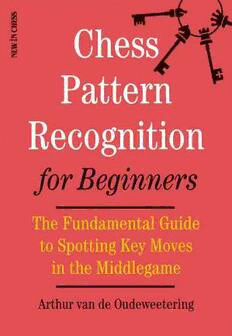
Chess Pattern Recognition for Beginners PDF
Preview Chess Pattern Recognition for Beginners
Chess Pattern Recognition for Beginners Arthur van de Oudeweetering Chess Pattern Recognition for Beginners The Fundamental Guide to Spotting Key Moves in the Middlegame New In Chess 2018 To my proud and always supportive parents Ferrie and Joke. To my ever encouraging and understanding family Edith, Julie and Ilja. © 2018 New In Chess Published by New In Chess, Alkmaar, The Netherlands www.newinchess.com All rights reserved. No part of this book may be reproduced, stored in a retrieval system or transmitted in any form or by any means, electronic, mechanical, photocopying, recording or otherwise, without the prior written permission from the publisher. Cover design: Volken Beck Supervision: Peter Boel Editing and typesetting: Frank Erwich Proofreading: Joe Petrolito, Sandra Keetman Production: Anton Schermer Have you found any errors in this book? Please send your remarks to [email protected]. We will collect all relevant corrections on the Errata page of our website www.newinchess.com and implement them in a possible next edition. ISBN: 978-90-5691-803-3 Contents Explanation of symbols Foreword by Vladimir Chuchelov Preface Part I Typical pawns and pieces Chapter 1 The lingering king Chapter 2 Queen in trouble Chapter 3 Rook(s) on the seventh rank Chapter 4 Botvinnik’s fearsome bishop Chapter 5 Kasparov’s favourite Chapter 6 Fischer’s knight Chapter 7 Opposites are not equal Chapter 8 Cousins from a distance Chapter 9 IDP: isolated doubled pawn Chapter 10 A central striker Chapter 11 Central supremacy Exercises Part I Part II When pawns meet Chapter 12 Reaching for the hook Chapter 13 When Harry meets g6 Chapter 14 Deceptive symmetry after the IQP Chapter 15 Breaking free Chapter 16 Flank attack! Part III When to exchange and when not to Chapter 17 King of all exchanges Chapter 18 Along the open file Chapter 19 What remains: towards a good knight versus a bad bishop Chapter 20 The ace of space Part IV Sacrifices – the classics Chapter 21 Bishop takes h7 Chapter 22 The Soviet sac Chapter 23 The silent knight sac Chapter 24 From Morphy to Magnus Chapter 25 Capa’s bishop sac Exercises Parts II, III and IV Solutions Epilogue Index of players Index of openings Bibliography Explanation of symbols The chessboard with its coordinates: White to move Black to move ♔ King ♕ Queen ♖ Rook ♗ Bishop ♘ Knight White stands slightly better Black stands slightly better White stands better Black stands better +– White has a decisive advantage –+ Black has a decisive advantage = balanced position ! good move !! excellent move ? bad move ?? blunder !? interesting move ?! dubious move Foreword by Vladimir Chuchelov In January this year, at the Tata Chess Tournament, I ran into Arthur, whom I know from the years when we were both trainers for the Dutch Chess Federation. We both took care of one of the national youth selections; I think he did the youngest group. That really is some time back now, but in recent years I noticed he had become a serious chess author. Moreover, when we met this year, he told me, amongst other things, that he was working on the book which is now in front of you. Arthur himself has provided an extensive Preface, in which he gives further information and explanation about the contents and structure of the book. Of course here I could expand on that, and select a couple of the many interesting fragments, but in general it feels unnecessary to me to go through the book with you as well. Instead, I will say a couple of words about the subject itself. Recognition of strategic patterns is a very essential matter; it really helps during a game. Once we see a certain familiar pattern, we can make a mental link with the current situation on the board and figure out the right way to proceed. Knowledge of different strategic ideas is directly linked to so-called intuition, which is a positional feeling that trainees should develop over the years. This goes for beginners as well as advanced players and even top players. It is part of our general chess development. In my own praxis, working mostly with advanced players, we rather deal with a complete strategical evaluation of positions, which is known to my students as the ‘strategic balance’. One specific strategic pattern will often play a role, but it will always be in the context of the whole evaluation, the pattern being just one
